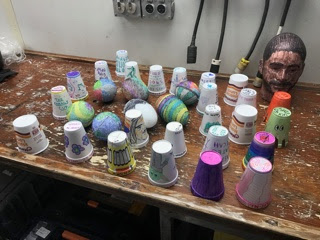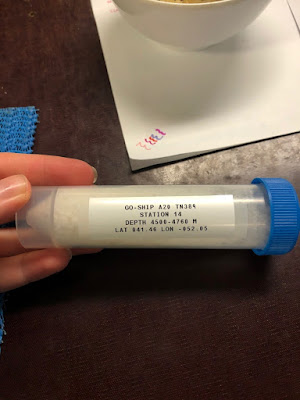Foraminifera are very small, amoeboid ocean protists (single celled, amoeba-like organisms) which live in the upper portion of the water column. Their tests (shells) are calcareous and are left in the fossil record after they die. While alive, they can be seen in the water column, especially in the lower latitudes where the ocean temperatures support growth (fig. 1). Though they have little to do with this particular cruise, they are the focus of my research. I use planktic foram fossils to study past climate with a current focus on the Arctic. I suspect I could start an entire blog about stable isotope geochemistry, so I'll keep my explanation here brief. Essentially, foram tests are made of calcium carbonate with oxygen obtained from the seawater they inhabit; therefore, they are representative of the isotopic ratios of the seawater. On larger scales this includes land ice mass changes, but on smaller time—and geographic—scales, these environmental changes are dependent on local seasonal and annual variables which can include freshwater input from rains and rivers and changes in sea ice, as examples. To provide further context, we can take the example of land ice mass. Understanding isotopes are the variations in atomic weight which exist in nature for a singular element (18O, 17O, 16O), we can look at what happens to the oceans during an ice age. All the ice on land has to come from precipitation over time. That precipitation comes from water vapor, which comes from the ocean. Lighter isotopes require less energy to evaporate to become that water vapor, leaving the oceans with more heavy isotopes and "enriching" the oceans in 18O. Subsequently, we can think about the precipitation, now lighter (containing more 16O relative to 18O) in isotopic ratio than the ocean. If we have a lot of rain, like a monsoon, over the ocean, the surface of the ocean will be flooded with "lighter" water, causing the mixed layer to become overall lighter than it previously was. Within that environment, forams live for approximately one month and thus represent one average month of the isotopic value of the water they inhabit and, by extension, can tell us about these influences. We can then ask questions like "how has Southeast Asian monsoon intensity changed in the last 50,000 years" or "how far has sea ice migrated into the Atlantic in geologic history" to look at the fluxes of water over time (and sometimes its origin). With modern methods, we're able to reach a seasonal resolution in some studies. It's absolutely astounding!
My interest in the North Atlantic mostly relates to its influence on the Arctic and is typically restricted to the subpolar Atlantic and the Fram Strait, but the N. Atlantic is, of course, interconnected and ocean currents do not pertain to one particular latitude, so gaining a more in-depth insight into the physical oceanography of the ocean as a whole greatly adds to my understanding of its influence on my research sites. Additionally, I use CTD data often in my work and learning the methods and the limitations of the collection process is beneficial as a CTD watch-stander on this leg. I planned on independently sampling for foraminifera on board, but, unfortunately, with the pandemic slowing shipping and making plans uncertain, I was unable to obtain the necessary equipment. Instead, I am collecting water samples to create a stable isotope record and targeting depths useful in foraminiferal research. I hope it will be informative and perhaps I, or someone else, will have another opportunity to pair the data with modern foraminiferal isotopic data in the future.
Our leg, A22, provides a unique opportunity to observe changes in real time through four ecologically important water masses: the Equatorial Warm Peripheral Water (EWPW), the Southern Sargasso Central Water (SSCW), the Northern Sargasso Central Water (NSCW), and the Non-equatorial Warm Peripheral Water (NWPW). These are not physical water masses, but relatively surficial demarcations defined by Ruddiman in 1969 based on patterns of foraminiferal diversity (fig. 2). The SSCW and NSCW have exceedingly low diversity while the NWPW and EWPW have high diversity. Foraminiferal diversity relates to the general state of zooplankton and productivity at a given site as well, extending the potential scope of the paper to others on the cruise.
Degree of diversity is measured as the number of species that constitute ≥2% of site assemblages. If a singular species constitutes half an assemblage (a randomly generated, fractional representation of the species present), it is considered dominant. The strength of that dominance is reflected in the actual percentage of that species. For example, Globigerinoides ruber makes up 45-60% of the ship's current location (25.47', -65.69'), while at my sites of study in the Arctic, Neogloboquadrina pachyderma (the typical cold dwelling foram) makes up 85-95% of site assemblages. G. ruber and N. pachyderma thus represent opposite ends of the temperature dominance scale. Typically, we expect a trend of increasing diversity from pole to equator, but the N. Atlantic doesn't follow this expected pattern. The equatorial Atlantic has many diversity minimums and maximum diversity is found around the periphery of the N. Atlantic gyre where nutrients levels are high, salinity is intermediate, and forams are moved by the currents creating lateral mixing of species. Otherwise, salinities below 30oN are too high to support any species besides G. ruber and any waters above 30oN are dependent on winter nutrient dumps to support productivity.
This brings us to another interesting change we'll traverse: latitude 30oN. Though this is an artificially drawn line, it represents the change from perpetually deep thermoclines with well mixed upper ~20m to seasonally variable, shifting thermoclines in the higher latitudes with much smaller (~5-10m) mixed layers. As it is spring going into summer, I am interested in noting zooplankton activity towards the end of our leg since this is the time of year where nutrient levels should be low up north. As we near this marked latitude, we've already seen a gradual shoaling of the thermocline and decreasing underwater vision profiler (UVP) activity (suggesting decreasing zooplankton presence). UVPs allow us to get real time, in-situ photographs of a wide range of organisms in the water column, courtesy of Stephanie O'Daly. Stephanie also very generously answers all my questions and shares papers and photos with our group. Despite the inability to absolutely identify the forams we've seen in her photos, I would hazard most of them would be G. ruber.
Figure 1 : Planktic, spinose foram at station 10, 576.2m depth. Scale bar is 2mm. Photo provided by Stephanie O'Daly.
Figure 2: Ruddiman (1969), ecologically distinct water masses in the N. Atlantic. Red overlay indicates the course of leg A22.
Reference: Ruddiman, William. "Recent Planktonic Foraminifera: Dominance and Diversity in North Atlantic Surface Sediments." Science 294, (June 6, 1969): 1164–67.



















